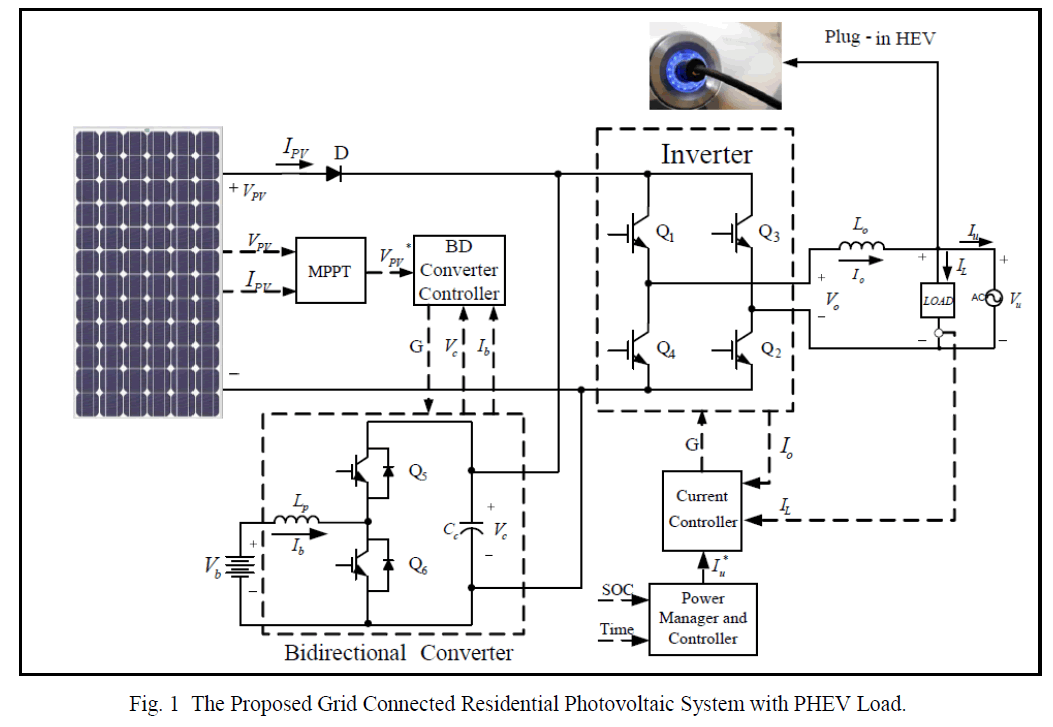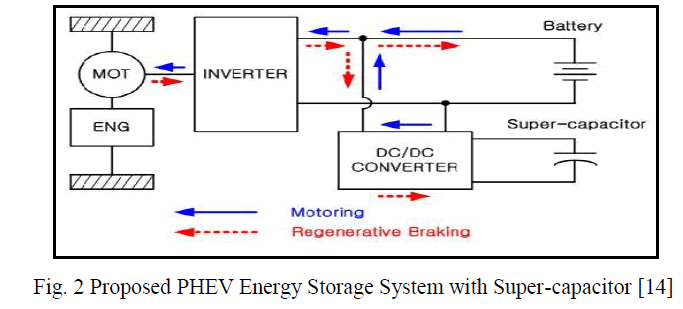ISSN ONLINE(2278-8875) PRINT (2320-3765)
ISSN ONLINE(2278-8875) PRINT (2320-3765)
Md Shamiur Rahman1, Asif Hassan1, Nasif Mahmud1, Ahmed Tashfin Iftekhar1, Mohammad Delwar Hossain Mazumder1
|
| Related article at Pubmed, Scholar Google |
Visit for more related articles at International Journal of Advanced Research in Electrical, Electronics and Instrumentation Engineering
A novel designing approach of a grid-connected residential photovoltaic (PV) system containing a plugin hybrid electric vehicle (PHEV) load along with a feasible power management mechanism are presented in this paper. In this system, PV arrays and battery packs are cascaded to supply power to the load. Solar energy is harvested by PV arrays, the terminal voltage of PV arrays is regulated by a DC/DC converter to track maximum power point (MPPT) using the incremental conductance method. Battery packs work as the energy storage system and the current controlled bi-directional DC/DC converter regulates the power flow between grid and battery. The interfaced inverter is also a bidirectional inverter.
Keywords |
| Grid, Photovoltaic, Plug in Hybrid Vehicle Load, Inverter, DC/DC Converter, Maximum Power Point (MPPT) |
I. INTRODUCTION |
| Energy demand is increasing thus conventional power generation structures require high level penetration of renewable energy sources. Solar Energy is the most widely utilized renewable energy source. The integration of a photovoltaic system into grid has become a major issue to be addressed due to unavailability and unpredictability of the source which originates energy distribution imbalance. Energy storage systems are one of the solutions for energy distribution imbalance issue in electrical power systems. Plug-in hybrid electric vehicles (PHEVs) are seen to replace conventional vehicles in most urban areas and populated cities because of less air pollution compared to internal combustion engine (ICE) vehicles. PHEVs as a flexible load can satisfy two main issues, first, increasing the penetration rate of renewable energy in microgrid, second, increasing the load factor [1]. As considerable number of vehicles are parked in the parking in most of the time. Since vehicles should be connected to grid after they are completely charged to use their energy storage capacity, it could be beneficial to pay incentives to vehicles owners and will play a vital role in demand response. |
II. SIGNIFICANCE & BACKGROUND LITERATURE |
| Growing consumer expectations, legislation pushing for lower emissions, increasing fuel prices, and the realization that petroleum is a finite resource are factors leading to ground breaking changes in the automotive industry, particularly in the realm of electrification of the drive train. Depending on the degree of electrification, the combination of the internal combustion engine (ICE) with an electric motor offers a wide range of benefits from reduced fuel consumption and emission reduction to enhance performance and supply of power-hungry hotel loads. Extensive research and development has been conducted on alternative-fuel vehicles, including hybrid electric vehicles (HEVs) and plug-in HEVs (PHEVs) [2]. The charging of PHEVs has an impact on the distribution grid because these vehicles consume a large amount of electrical energy and this demand of electrical power can lead to extra large and undesirable peaks in the electrical consumption. There are two main places where the batteries of PHEVs can be recharged: either on a car park, corporate or public, or at home. The electrical consumption for charging PHEVs may take up to 5% of the total electrical consumption in Belgium by 2030. For a PHEV with a range of 60 miles (100 km), this amount can increase to 8% taking into account a utility factor which describes the fraction of driving that is electrical [3]. |
| Overnight recharging can also increase the loading of base-load power plants and smoothen their daily cycle or avoid additional generator start-ups which would otherwise decrease the overall efficiency [4]. From the PHEV owner point of view, the batteries of the PHEV have to be charged overnight so the driver can drive off in the morning with a fully-charged battery. [15] This gives opportunities for intelligent or smart charging and inclusion of grid connected alternative energy sources. Three challenges we have to face to ease the path they are; efficient and effective conversion topology among utility, PV system and PHEV, power flow management and effective energy storage system for PHEV. Considering these three challenges the following model and controlling mechanism are proposed. |
III. RESEARCH OBJECTIVES AND OUTCOMES |
| Design modeling and implementation of Grid connected PV system with plug in hybrid vehicle as energy storage using advanced converter topology to improve the performance of existing system. |
| Developing hybrid battery-super capacitor model as Energy Storage System (ESS) instead of battery only to enhance battery life and evaluate the developed model in comparison with existing ESS model. |
| Development of power flow control strategy among PV module, plug in hybrid vehicle energy storage, local load and grid. |
| Analyzing on impact of plug in hybrid vehicles on distribution grid and providing viable solution |
IV. PROPOSED MODEL & METHODOLOGY |
| In the proposed model a simulated model and an algorithm to control and manage power flow of grid connected photovoltaic system with plug in hybrid vehicle load are developed. Proposed research model is based on three sub sections described below: |
| A. Conversion and Control Mechanism |
| The topology of proposed PV system consists of PV arrays, PHEV battery pack, DC/AC inverter and bi-directional DC/DC converter. In this connection, the DC/DC converter will control the terminal voltage of PV arrays for MPPT operation using Incremental conductance algorithm [5]. The DC/AC inverter and the DC/DC converter will manage the power flow between PV array, battery, load and the grid. During the availability of the solar source the DC/DC converter will charge the battery and PV arrays will supply power to the load through DC/AC inverter. In the case of non-insulation or less insulation, the stored energy in battery should be delivered to load through DC/DC converter and DC/AC inverter [6]. Therefore, the DC/DC converter has to be capable of conducting bi-directionally to charge and discharge the battery. The MPPT controller using incremental conductance method will provide the reference voltage. The output of voltage controller will work as the reference current to determine the power flow direction between PHEV battery pack and load. The current controllers will be improved by using sliding mode controllers which will make them capable of deciding to operate the converter as a buck converter to charge the battery or as a boost converter to discharge the battery pack. [7] |
| B. Power Management |
| Inverter is basically controlled by current controller which will be driven by current-mode Asynchronous sigmadelta modulation (CASDM) to reduce reactive power loss.[8] The current controller will take it reference from the power management system. This algorithm will give its decision according the SOC of the battery pack and time of the day. In day time if the battery is full, power manager forces the system to pump the power generated from the PV panels to grid or load but if the battery is not full, system supplies the power only for load and charges the battery pack with the extra energy from panels. If the solar energy is not enough to supply the load, required power is taken from the battery. In night time, load is supplied from battery if the SOC is over a minimum value. The battery is empty, the load is supplied from the grid and battery pack can be charged when the electrical energy price is low. Inverter also compensates the system by generating required reactive power and harmonics. [9][10] The sizing of the system is done according to the load profile and solar irradiance. Load profile is a combination of regular house load [11] and plug-in hybrid electric vehicle charging requirements and irradiance will be considered for AM1.5 condition with 1000 W/m2. |
 |
| C. Energy Storage System (ESS) |
| Ultracapacitors is important in the field of energy storage in hybrid electric vehicles. Ultracapacitors can be used to provide the short bursts of energy needed by hybrid electric vehicles during acceleration. Ultracapacitors do not need regular replacement like batteries because they are not as adversely affected during repetitive deep charging and discharging. This also implies that ultracapacitors are more environmentally friendly since they don’t need to be frequently discarded. Ultracapacitors can be fully charged from a total discharge within a few seconds. This makes them ideal for use in regenerative breaking systems. Ultracapacitors are not a prone to temperature effects as are batteries and can operate in temperatures as low as –40oC [12]. Ultracapacitors cannot replace batteries completely; however they can be used to complement each other. In the hybrid electric vehicle, the ultracapacitor can be used during vehicle operation [13] Refer to the fig 2 the ultracapacitor can be connected in shunt connection with DC/DC converter of the ESS of the PHEV. |
 |
V. CONCLUSION |
| In general, coordinated charging of plug-in hybrid electric vehicles can lower power losses and voltage deviations by flattening out peak power. However, when the choice of charging periods is rather arbitrary, the impact of the PHEV penetration level is large. The implementation of the coordinated charging is not without costs. By implementing proper control mechanism and efficient energy storage system the integration of PHEV can have a major impact in mitigating present crisis on power demand. |
References |
|